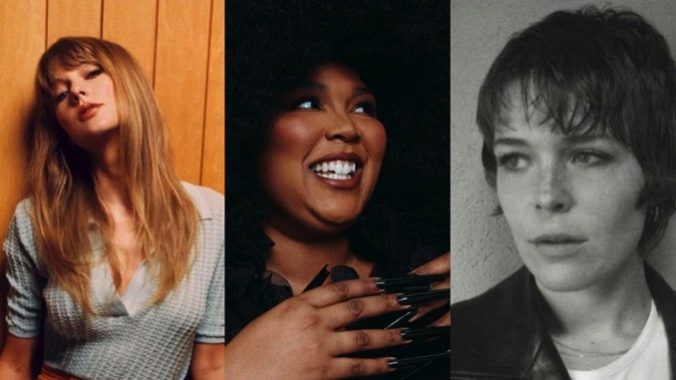The Curmudgeon: Taylor Swift, Lizzo & Maggie Rogers Show How Substantial “Pop Music” Can Be
Photos by Beth Garrabrant; courtesy of Lizzo; and by Olivia Bee
“Pop music” is a term with several shades of meaning. In its broadest sense it refers to all of popular music—everything that operates in the free-for-all marketplace, everything that isn’t a subsidized, high-culture art form like jazz or classical music, everything that isn’t meant for a local community, as traditional folk is.
In a slightly narrower sense, it means any music that lands on Billboard’s best-seller charts—or aspires to. More narrowly still, it refers to a particular slice of popular hits—those that emphasize earworm melodies, dance beats, highly polished production and big emotions. The beats and the production will evolve with each era. Tony Bennett’s strings and horns may sound different than Taylor Swift’s synthesizers and drum programs, but the basic approach is the same: make the music as accessible as possible to each era’s audience and reward those listeners with hummable tunes and universal feelings.
It’s important to understand these shades of meaning, because shorthand phrases such as “pop music” lubricate our conversation. Almost as much fun as listening to music is talking about it—in the pages of publications, on social media or in actual, in-person conversations. To get the most enjoyment out of such conversations, it’s important that we share a common vocabulary and know how to use it in different contexts. Those who criticize such phrases are trying to short-circuit our dialogue. Like all enemies of pleasure, they are puritans at heart.
When we say that Taylor Swift’s new album, Midnights, is a return to her “pop music” past, we’re using the narrowest definition. She’s always tried to be as popular as possible; even her debut country album and her two recent folk-rock albums, Folklore and Evermore, earned multiple platinum discs. But those three records didn’t lean on the repeating hooks and glossy sound of pure “pop” the way her biggest projects (Fearless, Red and 1989) did. The way Midnights does.
It’s important to keep in mind that this definition of “pop” describes the sound of the music, not its quality. Sure, some people will insist that only best-selling music has any real value, and others will insist that anyone leaning so heavily on hooks and beats can’t possibly have any substance. Both views are so often and so easily refuted that I won’t even bother doing so here. As much as any other genre—hip hop, Americana, punk or blues—“pop” can be good or bad. Every genre provides a few masterpieces, a lot of pretty-good efforts and a lot of mediocrity.
Midnights proves just how masterful and substantial the best “pop music” can be. Its power comes not from Swift’s modest but likable singing. It comes from her underrated songwriting and Jack Antonoff’s glistening pop production. The seductive sound pulls us in, and once we’re inside the song, the sharpened hooks and skillful language holds us there.
Sure, Swift’s subject matter is the same as ever: the ups and downs of a young woman’s feelings as she copes with romance and her peer group. Sure, that’s limited, and you might want her songwriting to take on other concerns as the Beatles and Stevie Wonder did after their early hits. But romance and friendship are the core subjects of pure “pop,” and as long as Swift chooses to work in that arena, those will be her subjects. Or, maybe, as long as those are her subjects, she will work in that arena.
Midnights opens with the throbbing, watery synth bass of “Lavender Haze,” a song that explores the foggy territory between love without trust and love without doubt, between one-night stands and marriage, between 21st century hook-ups and “the 1950s shit they want from me.”
Swift sings that she wants to stay in that no man’s land, that “lavender haze,” that “purple rain,” that blend of romance and freedom. Unlike most pop songs that try to reduce the world to binary outcomes—love forever or devastating break-up—this one offers something more nuanced, something mistier. And Antonoff’s damp, digital bloops and bleeps create the appropriate weather conditions for the lyrics.
The song defines what’s at stake for the rest of the album. Love is often disappointing, but it’s hard to give up on. But how much should you compromise to get it? How much of your independence can you sacrifice to get the affection you crave? This question is especially acute for the young women who are Swift’s core audience, who are still subject to expectations of wifehood, that “1950s shit.”
Swift addresses this dilemma explicitly on “Midnight Rain,” where she looks back through “a deep portal, time travel” at a teenage boyfriend who “wanted a bride. I wanted my own name…. He stayed the same; all of me changed.” Antonoff’s eerie waves of sound reinforce the Twilight Zone atmosphere. Swift’s vocal bounces along soothingly when she sings, “He wanted it comfortable,” but twists out of the harmony when she adds, “I wanted that pain.”
-

-

-

-

-

-

-

-

-

-

-

-

-

-

-

-

-

-

-

-

-

-

-

-

-

-

-

-

-

-

-

-

-

-

-

-

-

-

-

-








































